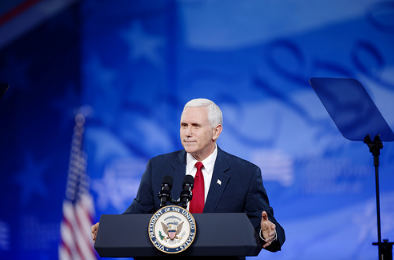
KABUL — Vice-President Mike Pence told Afghan President Ashraf Ghani on a secret visit Thursday to Afghanistan that the U.S. is ‘‘here to see this through’‘ as they discussed a newly announced U.S. strategy to break the stalemate in America’s longest war and consulted on upcoming parliamentary elections.
Pence’s surprise pre-Christmas visit was the first to the war-torn country by either Trump or the vice-president, and it came as the Trump administration charts a pathway to ending the 16-year war in Afghanistan.
‘‘We’re here to see this through,’‘ Pence told Ghani and Afghan Chief Executive Abdullah Abdullah at the presidential palace in Kabul, arriving after a helicopter ride through smoky, dark skies surrounding Afghanistan’s capital.
Later, at a rally-style event at Bagram Air Base, Pence told hundreds of U.S. troops that he believed ‘‘victory is closer than ever before.’‘
‘‘It’s because of all of you that we’re safe. It’s because of you that we’re free. It’s because of you that freedom has a future in Afghanistan and America and all across the wider world,’‘ Pence said.
Pence also received briefings from military leaders, including Gen. John Nicholson, the top U.S. commander in Afghanistan.
The White House restricted the use of cellphones and internet communications for a small group of journalists travelling with the vice-president, citing security concerns in Afghanistan. Pence was on the ground for about 6 1/2 hours before they were allowed to report on his whereabouts and activities.
Pence’s trip was focused on Trump’s strategy, released in August, to ‘‘fight to win’‘ in Afghanistan by attacking enemies, routing al-Qaida and preventing terrorist attacks against Americans. The first-year president has urged the U.S. to shift away from a ‘‘time-based’‘ approach to the protracted conflict by linking U.S. assistance to results and co-operation from the Afghan government, Pakistan and other partners.
The White House has described the new Afghanistan plan as a ‘‘regional’‘ strategy that aims to cultivate co-operation among other South Asian nations, including the overturning of Pakistan’s harbouring of elements of the Taliban.
At least 15,000 U.S. forces are in Afghanistan after Trump sent about 3,800 troops to the country this fall to enhance U.S. efforts to advise Afghan forces and conduct counterterrorism missions.
The expected deployment of hundreds more U.S. Army trainers to Afghanistan early next year could increase the total number of American forces there to nearly 16,000, U.S. officials have said.
Top U.S. officials, including Secretary of State Rex Tillerson and Defence Secretary Jim Mattis, met with Afghan leaders in recent months in hopes of stabilizing the country. But in a sign of the delicate security situation, the Taliban unleashed a barrage of rockets at the Kabul international airport in late September that targeted Mattis’ plane during his trip to the country. The U.S. responded with an airstrike.
The Trump administration has sought to foster strong relations with Ghani as he attempts to curb corruption and prepare for parliamentary elections next year. Ghani has expressed hope of bringing 80 per cent of the country back under the government’s control.
Pence met with Ghani in Germany in February and has spoken frequently with the Afghan president by phone or video conference. Pence met with Abdullah at the White House in November for consultations on the country’s security situation.
The U.S. and allied forces have been fighting a resurgent Taliban, which controls nearly half the nation, as well as an Islamic State group affiliate in Afghanistan, which continues to struggle with unrest following the 2001 U.S.-led invasion.
The influx of U.S. trainers is emblematic of the military’s renewed focus on building up Afghan forces so they can fight the insurgents and take control of their country’s security. That approach aims to reverse setbacks experienced by Afghan forces in recent years, as the Obama administration steadily reduced U.S. troop levels from a peak of roughly 100,000 in mid-2010.
U.S. leaders have also pressed NATO allies to increase their troop commitments to Afghanistan to help train and advise the Afghan forces and redouble the U.S.-led counterterrorism fight.
In recent weeks, American aircraft have targeted drug producing facilities in Afghanistan in a new effort to cut off Taliban funding. U.S. officials have estimated that the insurgents generate an estimated $200 million a year from poppy cultivation and opium production.
Another part of the effort includes preventing militants in Pakistan from crossing the mountainous border with Afghanistan to wage attacks and then return to safe havens in Pakistan, where they have had a long-standing relationship with the country’s intelligence agency.
The trip to Afghanistan represented the vice-president’s most high-profile — and secretive — foreign visit.
He presided over the Senate in an early Wednesday vote on a bill to cut taxes and then joined Trump for a Cabinet meeting and a White House event with Republican lawmakers celebrating final passage of the legislation. He slipped out of Washington on Wednesday afternoon and flew to Bagram aboard a C-17 military transport aircraft.
The trip followed an abrupt announcement from the White House that Pence would postpone until mid-January a planned visit to the Middle East, including stops in Egypt and Israel. The vice-president had been scheduled to depart for the Middle East on Tuesday night.